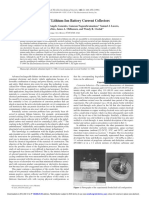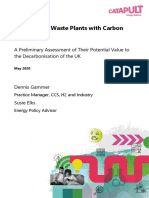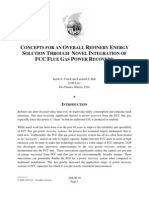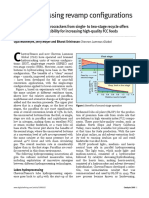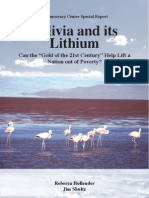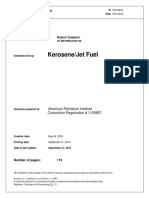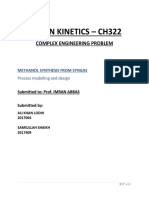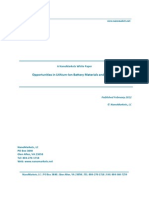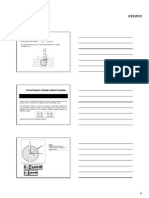Professional Documents
Culture Documents
April 2018 Interpreting FCC ECat Data
April 2018 Interpreting FCC ECat Data
Uploaded by
Nishant KumarOriginal Description:
Copyright
Available Formats
Share this document
Did you find this document useful?
Is this content inappropriate?
Report this DocumentCopyright:
Available Formats
April 2018 Interpreting FCC ECat Data
April 2018 Interpreting FCC ECat Data
Uploaded by
Nishant KumarCopyright:
Available Formats
Interpreting FCC equilibrium
catalyst data
Regular Ecat and fines analysis provides information to support optimum
performance from the FCC
Alexis Shackleford BASF
A
s part of best practice in fluid catalytic the catalyst (versus the unit which is impacted by
cracking (FCC) unit monitoring, routine feed slate and operating conditions).
analysis of equilibrium FCC catalyst (Ecat)
and fines is vital to maximise profitability and Fluidised activity test (FACT)
reliability. Ecat and fines analysis provides valu- The reported Ecat activity is the weight percent
able information on the FCC unit to assess oper- (wt%) conversion obtained for the catalyst sam-
ation, monitor performance, troubleshoot, ensure ple in an ACE unit run with a standard feedstock.
reliability, and optimise the unit. Conversion [Conv] is defined as:
BASF routinely analyses Ecat and fines data for
units around the world. This article describes the 100 – Light cycle oil (LCO wt%) – Bottoms (BOT
testing and interpretation of the data. BASF data wt%)
sheets are communicated through email or can
be downloaded from the company’s refinery pro- For reference:
file website. Kinetic conversion = [Conv] / (100 – [Conv])
Typically, FCC units send one sample of Ecat
per week to their catalyst supplier. In addition, Since the in-unit conversion is a function of
fines samples (slurry fines, flue gas fines such as the FCC process conditions, feedstock properties
TSS, ESP and scrubber water fines) should be and catalyst properties, the FACT activity pro-
sent monthly at a minimum. All Ecat samples are vides a separate evaluation of the catalyst con-
first decoked (to remove any remaining carbon tribution to the unit conversion. Often the term
on the regenerator catalyst) and measured for MAT is still used for activity (including FCC SIM
activity, particle size, physical properties, surface programmes) even though all major vendors use
areas, chemical analysis, and yields. These tests ACE testing today.
provide information about the yield performance Each Ecat sample is decoked and screened
(activity and yield selectivities) and fluidisation/ before being tested. The ACE activity is the car-
retention of the catalyst. While absolute values bon-free catalyst activity. The in-unit activity
are useful, trends are equally, if not more, impor- might be lower if the regenerated catalyst con-
tant for monitoring. tains significant amounts of residual carbon,
which will block access to cracking sites. For high
Advanced Cracking Evaluation1 (ACE) carbon on regenerated catalysts (CRC), this drop
BASF introduced ACE testing for standard Ecat is significant. At 0.3-0.4 wt% carbon, this can
evaluation in 2001, replacing fixed bed Micro lead to a 1-2 number drop in activity. For Ecat
Activity Test (MAT) units. This is a fluidised lab- with high CRC, BASF can run as received activity
oratory test measuring the catalyst activity, coke, with the carbon on the catalyst for comparison.
and product selectivities. The ACE unit is run at What impacts FACT? When fresh catalyst
constant operating conditions with a standard is added to an FCC unit, both the zeolitic and
feed so changes seen over time are due only to matrix portions deactivate significantly as the
www.digitalrefining.com/article/1001489 April 2018 1
rise in regenerator temperature
1.95 2100
FCF
and delta coke, often resulting in
1.80 decreased conversion. Catalyst
NI + V/4 − 4/3 Sb
Ni + V/4 − 4/3 Sb, ppm
1900
1.65 type will impact the coke factor,
but major changes are frequently
Coke factor
1.50 1700
1.35
a result of changing levels of
1500 contaminant metals (primarily
1.20
nickel [Ni] and vanadium) on the
1.05 1300 Ecat (see Figure 1). A common
0.90 equivalent metal calculation of
1100
0.75 nickel + ¼ vanadium – 4/3 anti-
0.60 900 mony (Sb) is used to normalise
Date the dehydrogenation activity of
these common metals.
Figure 1 Coke factor increasing with metals The commercial regenera-
tor temperature is influenced
by many factors including oper-
2.0 ating conditions (feed preheat
1.9 and reactor temperatures), cat-
1.8
alyst activity, feed qualities
(1050°F/565°C+ content and
1.7
Conradson carbon level), and
1.6 hardware. The FCF helps the
FDGF
1.5 refiner to isolate the effect of
1.4 the catalyst on the regenerator
1.3 temperature. It must be remem-
bered that the Ecat metals level
1.2
(which strongly influences the
1.1
FCF) depends on the feedstock
1.0 quality and the fresh catalyst
2000 2500 3000 3500 4000 4500
make-up rate.
Equivalent Ni
Fluidised dry gas factor (FDGF)
Figure 2 Fluidised dry gas factor (FDGF), the dry gas make of the catalyst, vs FDGF is the dry gas produc-
equivalent Ni = Ni + ¼ V – 4/3 Sb. Higher metals significantly increase the tion (C2 and lighter) adjusted for
dry gas make conversion. Hydrogen product,
and therefore FDGF, is strongly
catalyst ages. The rate of Ecat deactivation is influenced by metals contamination (see Figure
accelerated with increases in regenerator tem- 2). High dry gas yields take up a significant por-
perature and moisture, catalyst residence time, tion of the wet gas compressor capacity and may
and contaminant levels including vanadium (V), limit the FCC capacity.
alkali metals (sodium [Na], potassium [K]) and
alkaline earths (Ca). A rule of thumb: if vanadium Fluidised gas factor (FGF)
+ sodium increases by 1000 ppm on Ecat, expect FGF describes the ‘wet gas’ production (C4 and
~2 number decrease in activity. Ecat activity lighter) adjusted for conversion. Adding ZSM-5
increases with increased fresh catalyst make-up additive or lowering rare earth on the fresh cata-
rate and fresh catalyst activity. lyst will increase this value (see Figure 3).
Fluidised coke factor (FCF) Particle size distribution (PSD)
FCF provides a measure of the coke selectiv- The Ecat PSD provides important information on
ity of the equilibrium catalyst adjusted for con- the circulation and attrition characteristics of the
version. Increases in this value can show up as a catalyst, as well as on the performance of the FCC
2 April 2018 www.digitalrefining.com/article/1001489
cyclones. PSD is measured using
a laser light scattering spectrom- 1.2 0.50
FGF
eter (ASTM D4464-10). 0.45
P
The FCC unit needs a cat- 0.40
alyst with a range of particle 1.1
P, wt%
0.35
sizes to circulate the catalyst
0.30
effectively. Each unit has a dif-
FGF
1.0 0.25
ferent requirement for fines con-
tent (defined as either the 0-40 0.20
micron or 0-45 micron frac- 0.15
0.9
tion of the catalyst) in the Ecat
(see Figure 4). Some units might
require greater than 10% of 0.8
40 microns and smaller mate- Date
rial, while others might circu-
late catalyst well with less than Figure 3 Fluidised ‘wet’ gas factor (FGF) vs ZSM-5 content (using P as the
5% under 40 micron material. marker)
It is good practice for a refin-
ery to document the physical
properties of the catalyst and 15
the operational variables on the
unit when circulation problems
become evident.
0 to 40u, %
10
Signs the unit is having a
retention problem2
A trend of decreasing fines in the 5
Ecat is a cause for concern when
accompanied by a loss problem
on the unit. To troubleshoot, the 0
Date
amount and PSD of fines in the
slurry circuit, flue gas system
and stack should be checked to Figure 4 A unit’s healthy maintenance of the 0-40µ content
determine where the catalyst is
being lost. If poor fluidisation results, two pos- sive fresh catalyst transfer velocities. Excessive
sible interim measures are to increase the fines velocities (>300 ft/s or >90 m/s) in the feed noz-
content in the fresh catalyst or use a fluidisation zles can also cause significant catalyst attrition. A
aid. Some refiners had success recycling fines lower Ecat fines content coupled with an increase
back to the unit, but these particles are jagged in average particle size are classic symptoms of
rather than spherical and often do not improve damaged cyclones.
fluidisation due to their irregular shape. Keep in
mind that a finer catalyst can increase unit losses Apparent bulk density (ABD)
and increase stack opacity. ABD measures the uncompacted density of the
Either an increase in catalyst losses with no Ecat and is generally a function of the fresh cata-
change in PSD, or a trend of increasing 0-40 lyst. ABD is measured by pouring the sample into
micron material in the Ecat can indicate an a graduated cylinder and calculating the density
increase in catalyst attrition. In either case, the from the volume and weight of the free-fallen sam-
PSD of the fresh catalyst should be checked. ple (ISO 697/EN ISO 60).
Several factors on the unit can increase cata- ABD does not usually change unless the cat-
lyst attrition or cause a jet that will damage the alyst type changes. If the ABD increases (Ecat is
catalyst, such as a regenerator air grid problem, becoming denser), this can be a sign of catalyst
damaged stripping stream distribution, or exces- sintering. Very high regenerator temperatures,
www.digitalrefining.com/article/1001489 April 2018 3
78
77
76
Conversion, wt%
75
74
73
72
71
70 0.2 µm
69
130 140 150 160 170 180 Zeolite Matrix
TSA, m2/gm
Figure 6 TEM picture showing zeolite
Figure 5 A unit’s correlation between FACT conversion and TSA and matrix
poor stripping and extended use of torch oil can surface area via nitrogen absorption. While matrix
all sinter the catalyst by collapsing the pore struc- in cracking chemistry refers only to the amor-
ture. This will show up as a decrease in surface phous alumina structures, here any active sites in
area, an increase in bulk density, and a decrease these large pores are categorised as MSA, includ-
in pore volume. ing zeolite. Matrix surface area is important for
If the ABD decreases (catalyst is becoming less cracking heavy molecules and for pre-cracking oil
dense), iron is likely to be the culprit. High iron to ‘feed’ the zeolite. The external zeolite surface
feeds create nodules on the catalyst surface and area measured as matrix surface area is accessible
lower its ABD (without changing the catalyst’s to pre-crack the heavy molecules with better coke
particle density). selectivity over amorphous matrix (see Figure 6).
Total surface area (TSA) Zeolite surface area (ZSA)
Surface area is an attribute used by both catalyst ZSA is highly coke selective and primarily cracks
manufacturers and users to monitor the activity gasoil range material in the feedstock. ZSA is a
and the stability of the catalyst (see Figure 5). The major factor in determining the product selectiv-
TSA includes both zeolite and matrix surface areas. ities of the catalyst. The ZSA is the measurement
Surface area is determined by nitrogen adsorption of the small pore surface area of the zeolite deter-
of a decoked catalyst sample. Total catalyst surface mined by the difference in TSA and MSA.
area generally trends with catalyst activity. This
relationship is dependent on the catalyst type and Chemical properties
rare earth, so a correlation between surface area This chemical properties section reports the most
and activity might not be consistent between dif- common elements found on Ecats. Metals present
ferent catalysts. BASF uses ASTM D 3663-78 and in the feed normally deposit quantitatively on the
D 4365 methods for determining surface areas. catalyst, so the level of metals on Ecats depends
Other catalyst vendors may use a different method, on the amounts in the feed and the rate of fresh
often resulting in higher reported TSA values com- catalyst addition. These elements deposit on the
pared to BASF, on average 10-15 m2/gm. Ecats and can affect both the activity and selec-
Surface area loss is accelerated by high regen- tivity of the catalyst. BASF uses x-ray fluorescence
erator temperatures, steam in the regenera- spectrometry to determine chemicals (ASTM
tor, and catalyst poisons such as V and Na (see D7085-04). Elements that do not deposit on the
‘Chemical properties’ below). catalyst include sulphur, nitrogen, arsenic, chlo-
rine and mercury; these leave with either the flue
Matrix surface area (MSA) gas or products. Since they do not deposit on the
MSA is a measurement of the surface area in the catalyst, they have no permanent negative effect
large pore channels including external/exposed on yields.
4 April 2018 www.digitalrefining.com/article/1001489
L = 33 µm
20 µm 20 µm
Figure 7 Elemental map showing Figure 8 Elemental mapping show- Figure 9 Iron nodules on Ecat
nickel’s immobility by depositing ing vanadium deposition through-
primarily on the outside of an Ecat out an Ecat particle due to the
particle mobility of vanadium
Copper (Cu) FCC catalyst manufactures. This iron is not cat-
Copper is present in some feedstocks. It catalyses alytically active. Iron in FCC feed (referred
dehydrogenation reactions, leading to increased to as added iron) deposits on the surface of
hydrogen and coke. Copper is also present in the catalyst, forming iron nodules which are
some NOx reducing additives. spike-like protrusions on the surface of the cat-
alyst (see Figure 9). The iron nodules reduce the
Nickel (Ni) Ecat’s ABD, and at very high levels can cause
Nickel acts as a dehydrogenation agent. Nickel pore mouth plugging. To mitigate iron poison-
deposition increases the production of hydro- ing, choose a catalyst that has optimised sur-
gen and coke and is not mobile (see Figure 7). face porosity including any of the BASF line of
Its effects become noticeable above ~500 ppm catalysts.4
on Ecat and become significant above 1000 Chemically, iron acts as a mild dehydrogena-
ppm. Nickel has little impact on catalyst activity. tion catalyst, increasing hydrogen and coke (hav-
Antimony is commonly used as a passivator and ing one 10th the activity of nickel) and a mild CO
injected with the FCC feed to reduce the catalytic promoter (which can be a problem in partial burn
impact of nickel. The fresh catalyst can have met- units). Iron also increases SOx emissions by act-
als passivation functionalities incorporated such ing as an inverse SOx additive.
as specialty alumina or boron.3
Sodium (Na)
Vanadium (V) Sodium on Ecat is the total sodium from the feed
Vanadium is present in the heavier organome- and fresh catalyst. Sodium is usually present as
tallic compounds in many FCC feeds. It collapses a salt in the feed, most likely as sodium chlo-
the zeolite and deactivates the catalyst. Under ride. Changes in the level of sodium in the FCC
regenerator conditions, vanadium is mobile and feed can occur as a result of crude diet or opera-
moves from particle to particle (see Figure 8). tional problems at the desalter. Purchased gas-
The deactivation potential becomes noticeable at oils, which are run straight to the FCC, can also
~1000 ppm and significant at ~2000 ppm. The contribute to sodium contamination of the Ecat.
dehydrogenation activity of vanadium is about Sodium is a potent and irreversible poison that
one quarter that of nickel. deactivates the catalyst almost immediately. An
Vanadium can also come from SOx reduc- increase in sodium of 0.1 wt% can decrease activ-
tion additives. In the SOx reduction additive, the ity by 1-3 numbers, depending on the individual
vanadium is fixed and does not cause the detri- unit. Sodium and vanadium act synergistically,
mental reactions described above. Catalyst for- resulting in a decrease in activity beyond what
mulations can contain vanadium traps to combat would be expected by the individual contaminants
the detrimental effects of vanadium. alone and is increased as regenerator temperature
increases. Sodium, like all alkali metals, has been
Iron (Fe) shown to form lower melting point eutectics with
Iron is inherently present in the clay used by zeolite.
www.digitalrefining.com/article/1001489 April 2018 5
Chloride (Cl) Rare earth oxides (REO)
Common useful oxide to element
Chlorides from the feed do not conversion for Ecat chemicals Typical REO used in catalyst
deposit on the catalyst and can- manufacturing are lanthanum
not be measured. However, CaO ÷ 1.40 P2O5 ÷ 2.29 and cerium, often measured as
chlorides reactivate nickel Fe2O3 ÷ 1.43 TiO2 ÷ 1.67 La2O3 and CeO2. The rare earth
already deposited on the cat- K2O ÷ 1.20 V2O5 ÷ 1.79 content of a catalyst affects both
alyst surface, thus increasing MgO ÷ 1.66 Na2O ÷ 1.35 activity and selectivity. As the
the nickel’s dehydrogenation Na2O ÷ 1.35 NiO ÷ 1.27 rare earth content of a catalyst
activity, which in turn increases NiO ÷ 1.27 increases, the acid site density
hydrogen and coke. If sodium of the zeolite increases, resulting
is increasing, this may be an Table 1 in higher activity. For two
indication that chlorides are Ecats that are otherwise the
increasing as well. Another source of chlorides same (TSA, MSA, contaminants) but with differ-
can be from the fresh catalyst. Some catalyst ent REO levels, the higher REO catalyst will have
technologies contain chlorides, while BASF cata- a higher activity.
lysts do not. At the same time, an increase in the rare earth
content of the zeolite shifts the catalyst prod-
Carbon (C) uct selectivity towards more gasoline, fewer gas-
The level of CRC provides insight into the regen- oline olefins and fewer light olefins. An increase
erator operation. Higher temperature and oxygen in zeolite rare earth content reduces the gasoline
partial pressure (for instance, full CO combus- octane potential. Higher rare earth content also
tion) in the regenerator promote oxidation, leav- increases the coke making tendency of the cat-
ing less carbon on the regenerated catalyst. High alyst. This can show up as an increase in delta
CRC can result from poor distribution of catalyst coke on the unit, which tends to lower the cata-
and oxygen in the regenerator, low oxygen levels, lyst circulation rate and increase the regenerator
over promotion in partial burn units, and oper- temperature.
ating in deep partial burn. Typical carbon levels It should be noted that the important measure
on Ecat from a full combustion FCC are 0.05- of rare earth is the amount of rare earth on the
0.15 wt%. Typical levels from a partial burn unit zeolite, while the quantity reported on the Ecat
are 0.10-0.40 wt%. High carbon levels, above 0.3 sheet is rare earth on the catalyst. Therefore, the
wt%, block catalyst active sites, thus reducing rare earth content of different catalyst families
conversion. Carbon is measured by LECO CS 744 (particularly if one contains rare earth which is
and C744 by the combustion infrared detection not in the zeolite) may not be directly compara-
technique. ble. Other potential sources of REO on the cata-
lyst include additives for vanadium trapping, SOx
Alumina (Al) reduction, NOx reduction, and gasoline sulphur
Alumina is found in both the zeolite and matrix reduction.
components of the catalyst and can be used to
track catalyst changes. Alumina is also used as a Phosphorus (P)
catalyst binder. Phosphorus is used to stabilise ZSM-5 additive
The bulk Si/Al ratio in the catalyst does not and can be used to track the ZSM-5 inventory.
correlate with the Si/Al ratio in the zeolite. Since Phosphorus coming in with the feed has little to
different catalyst types have different alumina no impact on catalyst performance.
contents, the catalyst alumina content cannot be Phosphorus may also be found in fresh catalyst
used to infer the relative matrix content of differ- when used as an alternative to REO for stabilis-
ent catalysts nor the UCS. ing the Y-zeolite.
Titanium (Ti) Antimony (Sb)
The titanium in the catalyst is inherent from the Antimony is an additive used in some FCC units
clay source and is useful to track catalyst changes to passivate the effects of nickel. Antimony pas-
between catalyst manufactures. sivation decreases nickel activity, reducing
hydrogen and coke production. The amount of
6 April 2018 www.digitalrefining.com/article/1001489
passivation can be tracked by the level of anti- Molybdenum (Mo) can come from resid hydro-
mony and nickel on the Ecat. Typical antimony cracking units’ catalyst and acts as a dehydro-
levels on the ECat is on the order of 1/10th to genation catalyst in the FCC.
1/3rd the level of nickel. Not all refineries can Platinum (Pt) and Palladium (Pd) are the active
use antimony given toxicity concerns and/or sites in CO promoters that catalyse the combus-
increased NOx emissions concerns. Antimony tion of CO to CO2.
will also poison CO promoters.
Other available analyses
Other chemical analyses Pore volume (PV)
Magnesium (Mg) is used in some vanadium traps The C12 (dodecane) PV of the catalyst is a meas-
and SOx reduction additives. It can also be used urement of the catalyst void volume. The typical
to stabilise zeolite. If coming from the feed, it acts range for C12 PV of an ECat is 0.32-0.50 cc/g.
as a milder base than sodium to reduce activity.
Calcium (Ca) is an alkaline earth metal Relative platinum content (RPC)
that acts similarly to sodium to destroy zeo- Relative platinum content is platinum measured
lite. Calcium is used in some vanadium traps. in ppm multiplied by 370. The lower detection
When used in vanadium traps, it does not cause limit is 0.2 ppm for Pt or a 74 RPC.
deactivation.
Potassium (K) is an alkali metal that acts simi- CO index
larly to sodium but to a lesser extent. The CO Index test measures the effectiveness
Manganese (Mn) is an uncommon feed con- of the CO promoter in the catalyst. A low met-
taminant that has mild dehydrogenation proper- als, unpromoted catalyst will typically have a CO
ties. It has also been used as a nickel passivating index of less than 10. A fully promoted catalyst
agent developed by Gulf (Chevron), but is not in will typically have a CO index above 25.
use today.
Lead (Pb) can be present in some feeds though Unit cell size (UCS)
is quite unusual since use of lead to enhance gas- This is a measure of the average unit cell
oline octane was discontinued. At levels of even size of zeolite using x-ray diffraction. UCS is
100 ppm, lead poisons CO promoters. Lead also an estimate for framework aluminium (Al)
acts as a dehydrogenation catalyst, but due to atoms. Higher UCS means more Al atoms,5
the low levels this is not a concern today. If lev- more acid sties and more hydrogen trans-
els start approaching 1000 ppm activity will be fer. In general, a catalyst with low UCS indi-
impacted. cates a maximum olefin catalyst while high
Tin (Sn) has been used as a vanadium passiva- UCS indicates a maximum gasoline catalyst.
tor but is not widely used. Factors affecting the UCS include REO content,
Zinc (Zn) is found in some gasoline sulphur fresh catalyst sodium content, thermal deac-
reduction additives. tivation and hydrothermal deactivation. The
Bismuth (Bi) has been used as a nickel pas- typical range for an Ecat is 24.25-24.40 Å.
sivator developed by Gulf (Chevron), but is not
widely used. Umb/Umf
Barium (Ba) has been used by some FCC cat- This is the ratio of the minimum bubbling and
alyst manufacturers as a vanadium trap. More minimum fluidisation velocity, also called bed
recently it has been showing up in tight oil feeds expansion. When this ratio is larger than one,
and other opportunity feedstocks. As long as the solid particles are able to be fluidised (the bed
catalyst contains a REO stabilised zeolite, it has expands before bubbling occurs). The larger the
no impact. ratio, the easier circulation is. Typical values are
Silica is a key component of clay and zeolite. in the range 1.8-2.5. The value reported on the
It can also be used as part of a binder system for Ecat sheet is based on the G Factor equation.5
incorporated catalysts. Silica content can be used
to monitor catalyst changes. Silica may come References
from the feed or anti-foaming agents used in the 1 Kayser J C, Versatile fluidized bed reactor, US Pat. 6,069,012,
coker and will have no impact on the catalyst. 1998.
www.digitalrefining.com/article/1001489 April 2018 7
2 Kuo R, Tan A, Troubleshooting catalyst losses in the FCC unit, has provided FCC R&D testing support. She holds a BS in chemical
Hydrocarbon Processing Advanced Catalysis, 2017. engineering from Michigan State University.
3 Shackleford A, Yilmaz B, Breaking ground, Hydrocarbon
Engineering, Nov 2014, 30.
4 Shackleford A, Clough M, Iron poisoning investigation enables
opportunities for success, Hydrocarbon Processing, Sept 2017, LINKS
49.
5 The Abrahmasen and Geldart equation. Abrahamsen A R, More articles from: BASF Corporation, Catalysts
Geldart D, Powder Technology 26, 1980, 35. Division
More articles from the following categories:
Alexis Shackleford is the Technical Service Specialist for BASF.
Catalysts & Additives
She is involved in FCC catalyst troubleshooting, technical service,
Fluid Catalytic Cracking
publications, presentations, and new product introduction, and
8 April 2018 www.digitalrefining.com/article/1001489
You might also like
- ECP 224 Test 2 2020 SolutionDocument6 pagesECP 224 Test 2 2020 SolutionCaleb MunyairiNo ratings yet
- Corrosion of Lithium-Ion Battery Current CollectorsDocument9 pagesCorrosion of Lithium-Ion Battery Current CollectorsGonzalo CeballosNo ratings yet
- ExxonMobil Chalmette Refining LLC MSDS FCC Spent CatalystDocument8 pagesExxonMobil Chalmette Refining LLC MSDS FCC Spent CatalystGeauxGreenNo ratings yet
- Agbami Reservoir FluidDocument6 pagesAgbami Reservoir Fluidokey obiNo ratings yet
- Multiphase Reactor Engineering for Clean and Low-Carbon Energy ApplicationsFrom EverandMultiphase Reactor Engineering for Clean and Low-Carbon Energy ApplicationsYi ChengNo ratings yet
- Biogas ExampleDocument10 pagesBiogas ExamplePargi anshuNo ratings yet
- MIXED PLASTIC RECYCLING PLANT STUW - HT - CHE - 2020 - Carducci - NunzioDocument52 pagesMIXED PLASTIC RECYCLING PLANT STUW - HT - CHE - 2020 - Carducci - NunzioDHSanjNo ratings yet
- 2021 HE CleanH2Monitor 2021Document139 pages2021 HE CleanH2Monitor 2021Paolo PagellaNo ratings yet
- LP PG Conversion To Thar CoalDocument3 pagesLP PG Conversion To Thar CoalRaja Zeeshan100% (1)
- 33 - Forecasting Carbon Emissions Future Prices UsingDocument32 pages33 - Forecasting Carbon Emissions Future Prices UsingTheRealCodiciaNo ratings yet
- Energy From Waste Plants With Carbon Capture FinalDocument34 pagesEnergy From Waste Plants With Carbon Capture FinalJonson CaoNo ratings yet
- Ecat Ssat Syllabus 2024Document1 pageEcat Ssat Syllabus 2024a54050519No ratings yet
- PRT RelianceDocument26 pagesPRT Relianceficky_iitdNo ratings yet
- Mukherjee Et Al. (2005) - Hydroprocessing Revamp ConfigurationsDocument7 pagesMukherjee Et Al. (2005) - Hydroprocessing Revamp Configurationsvazzoleralex6884No ratings yet
- The Battery Metals Market in 2021 1Document56 pagesThe Battery Metals Market in 2021 1cipta irawan100% (1)
- Grantham Briefing Paper - Carbon Capture Technology - November 2010Document20 pagesGrantham Briefing Paper - Carbon Capture Technology - November 2010Jonson CaoNo ratings yet
- Waste To Energy EN Jun2022-WEBDocument8 pagesWaste To Energy EN Jun2022-WEBHappy WeddingNo ratings yet
- 2018-08-01 Chemical Engineering WorldDocument69 pages2018-08-01 Chemical Engineering WorldAlis PastranaNo ratings yet
- Fundementals of Heat and Mass Transfer Revised 3rd Edition by C.P. KotandaramanDocument729 pagesFundementals of Heat and Mass Transfer Revised 3rd Edition by C.P. KotandaramanAkhil GuliaNo ratings yet
- DHDT BaiscsDocument2 pagesDHDT BaiscsAvik Bhai100% (1)
- IOCL Summer Training ReportDocument33 pagesIOCL Summer Training ReportSiddharth Rohilla (M22MS074)100% (1)
- Eia Saudiarabien Petroch 1Document15 pagesEia Saudiarabien Petroch 1moheauNo ratings yet
- Anhydrous Hydrochloric Acid: Production and TransportationDocument12 pagesAnhydrous Hydrochloric Acid: Production and Transportationup4allNo ratings yet
- Operating Instructions DB-033-961017 E: FH 40 G Dose Rate Measuring UnitDocument98 pagesOperating Instructions DB-033-961017 E: FH 40 G Dose Rate Measuring Unitbiruk girma100% (1)
- 02 - 21 - 2018 - ChE Plant Design - Synthetic Zeolite From Coal Fly Ash (CFA)Document130 pages02 - 21 - 2018 - ChE Plant Design - Synthetic Zeolite From Coal Fly Ash (CFA)Juhlian V. SantosNo ratings yet
- Polymer Electrolyte Membrane (Pem) Fuel CellDocument16 pagesPolymer Electrolyte Membrane (Pem) Fuel CellEldhose ShajuNo ratings yet
- FL - CB - Organic Chloride Test Methods - USA (1) 11.1.20Document1 pageFL - CB - Organic Chloride Test Methods - USA (1) 11.1.20Marvin Mendez GonzalesNo ratings yet
- Review Amine Based Capture Review - IChemE - PartA - Full - Paper - V9 - 28may2010Document23 pagesReview Amine Based Capture Review - IChemE - PartA - Full - Paper - V9 - 28may2010Ghochapon MongkhonsiriNo ratings yet
- Carbon Capture and Sequestration Projects Benefit From Enhanced Oil RecoveryDocument3 pagesCarbon Capture and Sequestration Projects Benefit From Enhanced Oil RecoveryGabriel DiazNo ratings yet
- SPE - CO2 - SLB 98617 MS PDocument10 pagesSPE - CO2 - SLB 98617 MS PKarim BensadallahNo ratings yet
- Fuel CellDocument12 pagesFuel CellsaisenthNo ratings yet
- Hydrotreating Catalytic Processes For Oxygen RemovalDocument31 pagesHydrotreating Catalytic Processes For Oxygen Removalr_nagpalNo ratings yet
- Proton Exchange Membrane (PEM) in Fuel Cells: A Review: March 2010Document33 pagesProton Exchange Membrane (PEM) in Fuel Cells: A Review: March 2010eli_aguirre_22No ratings yet
- Hydrogen'S Hidden Emissions: Shell's Misleading Climate Claims For Its Canadian Fossil Hydrogen ProjectDocument19 pagesHydrogen'S Hidden Emissions: Shell's Misleading Climate Claims For Its Canadian Fossil Hydrogen ProjectBeril SirmacekNo ratings yet
- Bolivia and Its LithiumDocument31 pagesBolivia and Its LithiummontagesNo ratings yet
- Water Purification SystemDocument20 pagesWater Purification Systemendalehadgu2866100% (1)
- Preparation and Rate of Hydrolysis of Boric Acid EstersDocument8 pagesPreparation and Rate of Hydrolysis of Boric Acid Estersfabian cotacioNo ratings yet
- US Patent Manufacturing of Propylene GlycolDocument5 pagesUS Patent Manufacturing of Propylene GlycolRegiyanti RNo ratings yet
- Jet Fuel PropertiesDocument119 pagesJet Fuel PropertiesJAN JERICHO MENTOYNo ratings yet
- Chapter 21Document119 pagesChapter 21Jia-shi ChenNo ratings yet
- AIChE Journal - 2022 - Sharma - A Hybrid Science Guided Machine Learning Approach For Modeling Chemical Processes A Review PDFDocument19 pagesAIChE Journal - 2022 - Sharma - A Hybrid Science Guided Machine Learning Approach For Modeling Chemical Processes A Review PDFAhmad SyauqiNo ratings yet
- Growth of Escherichia Coli in A 5 Litre Batch Fermentation VesselDocument15 pagesGrowth of Escherichia Coli in A 5 Litre Batch Fermentation VesselAs'ad Mughal100% (2)
- A Technical Basis For Carbon Dioxide StorageDocument92 pagesA Technical Basis For Carbon Dioxide StorageMuhammad AwaisNo ratings yet
- Methanol Synthesis From SyngasDocument38 pagesMethanol Synthesis From SyngasShahabuddin Khan NiaziNo ratings yet
- Wiley Online BooksDocument64 pagesWiley Online BooksAlexander Seminario0% (1)
- Paint Testing ManualDocument11 pagesPaint Testing ManualEtmad NomanNo ratings yet
- Process in Colloid and Polymer Science PDFDocument317 pagesProcess in Colloid and Polymer Science PDFMaria ClaraNo ratings yet
- Chapter5b Crackingffcu 170106114843Document26 pagesChapter5b Crackingffcu 170106114843loopkkNo ratings yet
- Otc 17355https://www - Scribd.com/upload-Document?archive - Doc 235698286&escape False&metadata ("Context":"archive","page":"read","action":"toolbar - Download","logged - In":false,"platform":"web") #Document10 pagesOtc 17355https://www - Scribd.com/upload-Document?archive - Doc 235698286&escape False&metadata ("Context":"archive","page":"read","action":"toolbar - Download","logged - In":false,"platform":"web") #GNo ratings yet
- Hydrogen Production With NuclearDocument4 pagesHydrogen Production With Nuclearstanleyameyerhhoh2hydrogenNo ratings yet
- Brochure - NR Electric Microgrid Solution v1.2Document16 pagesBrochure - NR Electric Microgrid Solution v1.2MostafaHeshmatNo ratings yet
- Immersion Cooling For Green Computing V1.0Document23 pagesImmersion Cooling For Green Computing V1.0embsbrNo ratings yet
- Modelling of Liquid Hydrogen Boil-OffDocument16 pagesModelling of Liquid Hydrogen Boil-OffelmabroukiNo ratings yet
- Good Paper On Amine Modf Co2Document10 pagesGood Paper On Amine Modf Co2debashis pandaNo ratings yet
- UntitledDocument147 pagesUntitledmarsulexNo ratings yet
- DOE Gasification Program OverviewDocument147 pagesDOE Gasification Program OverviewAshishrock Singh100% (1)
- Non Conventional Energy SourcesDocument40 pagesNon Conventional Energy SourcesPriyanka Vedula100% (1)
- Chapter 23 Thermophilic Biohydrogen Production PDFDocument12 pagesChapter 23 Thermophilic Biohydrogen Production PDFaegosmithNo ratings yet
- Status Report Final 2019 Task33Document125 pagesStatus Report Final 2019 Task33undyjklNo ratings yet
- 2 Sulphur and Sulphuric Acid IndustriesDocument39 pages2 Sulphur and Sulphuric Acid IndustriesChuka OmeneNo ratings yet
- White Paper Lithium Ion MaterialsDocument10 pagesWhite Paper Lithium Ion MaterialsNanoMarketsNo ratings yet
- Impressions Materials PDFDocument51 pagesImpressions Materials PDFfsjNo ratings yet
- Barfell HoseLiquid HoseDocument24 pagesBarfell HoseLiquid HoseAlias IsmailNo ratings yet
- Moist Air Properties and Air Conditioning ProcessesDocument37 pagesMoist Air Properties and Air Conditioning ProcessesAlex Chan100% (1)
- Inorganic Chemistry Lab 2Document7 pagesInorganic Chemistry Lab 2apple75% (4)
- Temperature Calibrator Typo Ote-T700Document2 pagesTemperature Calibrator Typo Ote-T700moncor59650% (1)
- Potential Flow - Chapter 6 - 3 (2012)Document6 pagesPotential Flow - Chapter 6 - 3 (2012)MARUMO_LEVYNo ratings yet
- USP Reference Standards Catalog: Last Updated On: November 7, 2020Document295 pagesUSP Reference Standards Catalog: Last Updated On: November 7, 2020Daryl Barrios LamedaNo ratings yet
- FinalDocument57 pagesFinalNayana P BabuNo ratings yet
- CSR Vs CRI Graph Coalformetallurgicalcokeproduction PDFDocument24 pagesCSR Vs CRI Graph Coalformetallurgicalcokeproduction PDFJANET GTNo ratings yet
- Grin Do MeterDocument2 pagesGrin Do MeterHeru SuliantoNo ratings yet
- Physico-Chemical and Mineral Analysis of Some Surface and Underground Waters From Iron Mining Zone of Kogi State, NigeriaDocument4 pagesPhysico-Chemical and Mineral Analysis of Some Surface and Underground Waters From Iron Mining Zone of Kogi State, NigeriaInternational Organization of Scientific Research (IOSR)No ratings yet
- Composite MaterialsDocument399 pagesComposite MaterialsCharlton S.Inao100% (1)
- 22 - Rigid ExampleDocument23 pages22 - Rigid ExampleApril AdmiresNo ratings yet
- Tempconversion PDFDocument6 pagesTempconversion PDFPravat TiadiNo ratings yet
- Chemical Resistance Information For Plastic and Metal Valves and FittingsDocument5 pagesChemical Resistance Information For Plastic and Metal Valves and FittingsRaakze MoviNo ratings yet
- Working of Helio DisplayDocument28 pagesWorking of Helio DisplayGaurav ReddyNo ratings yet
- Lattice Boltzmann MethodDocument15 pagesLattice Boltzmann MethodsvkindiaNo ratings yet
- Eutectic Solidification Processing PDFDocument2 pagesEutectic Solidification Processing PDFJames100% (1)
- Analiza-Termica BROSCHUREDocument68 pagesAnaliza-Termica BROSCHUREPiranha TourniquetNo ratings yet
- Flowserve ANSI-Pumps PDFDocument68 pagesFlowserve ANSI-Pumps PDFArup MahantaNo ratings yet
- Seminar Presentation Topic: Cryogenic Grinding: Submitted by Amal A Menon S7 Mech ADocument19 pagesSeminar Presentation Topic: Cryogenic Grinding: Submitted by Amal A Menon S7 Mech AAmal MenonNo ratings yet
- NR-222001-Thermal Engineering and Heat TransferDocument8 pagesNR-222001-Thermal Engineering and Heat TransferSrinivasa Rao GNo ratings yet
- 2507 Spec SheetDocument22 pages2507 Spec SheetzhangjieNo ratings yet
- 2020 2021 Class IX Chemistry Part 3 AWDocument8 pages2020 2021 Class IX Chemistry Part 3 AWShiv GorantiwarNo ratings yet
- Protein CalculationDocument3 pagesProtein CalculationIrfan SalimNo ratings yet
- Lkbsis54 Sodium-30335Document2 pagesLkbsis54 Sodium-30335nmakrygNo ratings yet
- Cacao LeavesDocument3 pagesCacao LeavesMarlyn MabalotNo ratings yet
- INChO2020 Solutions 20200204Document9 pagesINChO2020 Solutions 20200204kastonoNo ratings yet
- D 1608 - 98 Rde2mdgtotgDocument6 pagesD 1608 - 98 Rde2mdgtotgJason RogersNo ratings yet

